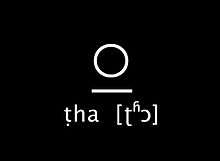Odia phonology
| Odia language |
|---|
| Overview |
|
| Grammar |
|
This article is about the phonetics and phonology of the Odia language.

Pronunciation of Odia alphabet.
Odia has twenty-eight consonant phonemes, two semivowel phonemes and six vowel phonemes.
Vowel
| Front | Back | |
|---|---|---|
| High | i | u |
| Mid | e | o |
| Low | a | ɔ |
All vowels except /o/ also have nasal counterparts, but these are not always contrastive. Final vowels are standard and pronounced, e.g. Odia [pʰulo] contra Bengali [pʰul] "flower".[1]
Consonants
| Bilabial | Alveolar /Dental |
Retroflex | Palatal | Velar | Glottal | ||
|---|---|---|---|---|---|---|---|
| Nasal | m | n | ɳ | (ŋ) | |||
| Stop/ Affricate |
voiceless | p | t̪ | ʈ | tʃ | k | |
| voiceless aspirated | pʰ | t̪ʰ | ʈʰ | tʃʰ | kʰ | ||
| voiced | b | d̪ | ɖ | dʒ | ɡ | ||
| voiced aspirated | bʱ | d̪ʱ | ɖʱ | dʒʱ | ɡʱ | ||
| Fricative | ɳ | h | |||||
| Flap | ɾ | ɺ̢[2] | |||||
| Lateral approximant | l | ||||||
The velar nasal [ŋ] is given phonemic status in some analyses. Nasals assimilate for place in nasal–stop clusters. /ɖ ɖʱ/ have the flap allophones [ɽ ɽʱ] in intervocalic position and in final position (but not at morpheme boundaries). Stops are sometimes deaspirated between /s/ and a vowel or an open syllable /s/+vowel and a vowel. Some speakers distinguish between single and geminate consonants.[3]
References
Bibliography
- Masica, Colin (1991). The Indo-Aryan Languages. Cambridge Language Surveys. Cambridge: Cambridge University Press. ISBN 978-0-521-29944-2.
- Ray, Tapas S. (2003). "Oriya". In Cardona, George; Jain, Dhanesh. The Indo-Aryan Languages. Routledge. pp. 485–522. ISBN 9780700711307.
This article is issued from Wikipedia - version of the 3/3/2016. The text is available under the Creative Commons Attribution/Share Alike but additional terms may apply for the media files.